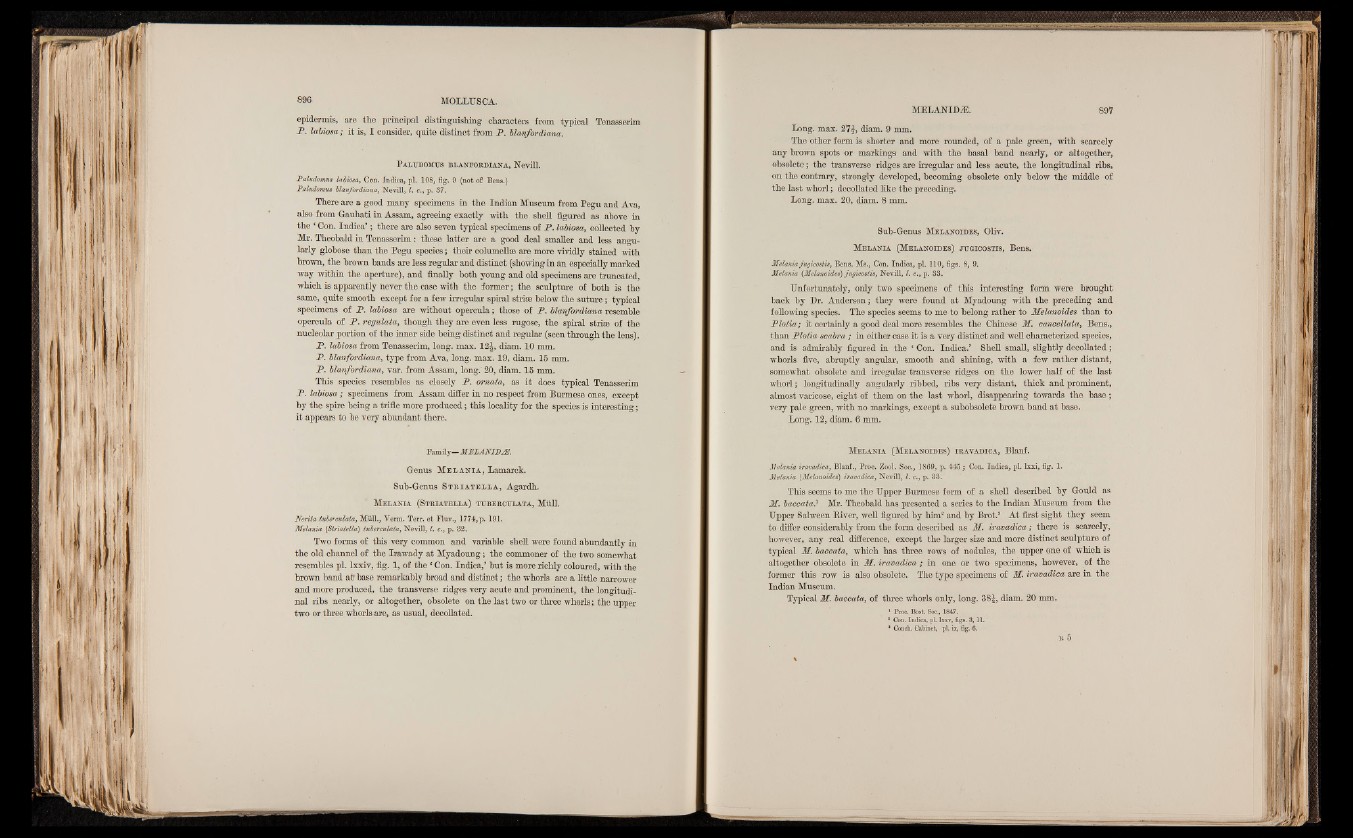
epidermis, are the principal distinguishing characters from typical Tenasserim
P . labiosa; it is, I consider, quite distinct from P . blanfordiana.
P a l u d o m t j s b l a n f o r d ia n a , Nevill.
Paludomus labiosa, Con. Indiea, pi. 108, fig. 9 (not of Bens.)
Pflludomus blanfordiana, Nevill, I. c., p. 87.
There are a good many specimens in the Indian Museum from Pegu and Ava,
also from Gauhati in Assam, agreeing exactly with the shell figured as above in
the ‘ Con. Indiea*; there are also seven typical specimens of P. labiosa, collected by
Mr. Theobald in Tenasserim: these latter are a good deal smaller and less angularly
globose than the Pegu species; their columellas are more vividly stained with
brown, the brown bands are less regular and distinct (showing in an especially marked
way within the aperture), and finally both young and old specimens are truncated,
which is apparently never the case with the former; the sculpture of both is the
same, quite smooth except for a few irregular spiral striae below the suture; typical
specimens of P. labiosa are without opercula; those of P . blanfordiana resemble
opercula of P . regulata, though they are even less rugose, the spiral striae of the
nucleolar portion of the inner side being distinct and regular (seen through the lens).
P. labiosa from Tenasserim, long. max. 12£, diam. 10 mm.
P. blanfordiana, type from Ava, long. max. 19, diam. 15 mm.
P . blanfordiana, var. from Assam, long. 20, diam. 15 mm.
This species resembles as closely P. omata, as it does typical Tenasserim
P. labiosa ; specimens from Assam differ in no respect from Burmese ones, except
by the spire being a trifle more produced; this locality for the species is interesting;
it appears to be very abundant there.
Family— MPZANIDJE.
Genus M e l a n i a , Lamarck.
Sub-Genus S t e -i a t e l l a , Agardh.
M e l a n i a ( S t b ia t e l l a ) t t jb e r c t jl a t a , Mull.
Nerita tuberculata, Mull., Verm. Terr, et Fltiv., 1774, p. 191.
Melania (Striatella) tuberculata, Nevill, I. c., p. 82.
Two forms of this very common and variable shell were found abundantly in
the old channel of the Irawady at Myadoung; the commoner of the two somewhat
resembles pi. lxxiv, fig. 1, of the * Con. Indiea,’ but is more richly coloured, with the
brown band afr base remarkably broad and distinct; the whorls are a little narrower
and more produced, the transverse ridges very acute and prominent, the longitudinal
ribs nearly, or altogether, obsolete on the last two or three whorls; the upper
two or three whorls are, as usual, decollated.
a s p
MELANIDiE. 897
Long. max. 27£, diam. 9 mm.
The other form is shorter and more rounded, of a pale green, with scarcely
any brown spots or markings and with the basal band nearly, or altogether,
obsolete; the transverse ridges are irregular and less acute, the longitudinal ribs,
on the contrary, strongly developed, becoming obsolete only below the middle of
the last whorl; decollated like the preceding.
Long. max. 20, diam. 8 mm.
Sub-Genus M e l a n o id e s , Oliv.
M e l a n i a (M e l a n o id e s ) j t jg ic o st is , Bens.
Melania jugieostis, Bens. Ms., Con. Indiea, pi. 110, figs. 8, 9.
Melania (Melanoides) jugieostis, Nevill, I. c., p. 88.
Unfortunately, only two specimens of this interesting form were brought
back by Dr. Anderson; they were found at Myadoung with the preceding and
following species. The species seems to me to belong rather to Melanoides than to
JPlotia; it certainly a good deal more resembles the Chinese M. cancellata, Bens.,
than JPlotia scabra; in either case it is a very distinct and well characterized species,
and is admirably figured in the ‘ Con. Indiea.’ Shell small, slightly decollated;
whorls five, abruptly angular, smooth and shining, with a few rather distant,
somewhat obsolete and irregular transverse ridges on the lower half of the last
whorl; longitudinally angularly ribbed, ribs very distant, thick and prominent,
almost varicose, eight of them on the last whorl, disappearing towards the base ;
very pale green, with no markings, except a subobsolete brown band at base.
Long. 12, diam. 6 mm.
M e l a n i a (M e l a n o id e s ) ir a v a d ic a , Blanf.
Melania iravadica, Blanf., Proc. Zool. Soc., 1869, p. 445; Con. Indiea, pi. lxxi, fig. 1.
Melania (.Melanoides) iravadica, Nevill, I. c., p. 88.
This seems to me the Upper Burmese form of a shell described by Gould as
M. baccata.1 Mr. Theobald has presented a series to the Indian Museum from the
Upper Salween River, well figured by him2 and by Brot.3 At first sight they seem
to differ considerably from the form described as M. iravadica ; there is scarcely,
however, any real difference, except the larger size and more distinct sculpture of
typical M. baccata, which has three rows of nodules, the upper one of which is
altogether obsolete in M. iravadica; in one or two specimens, however, of the
former this row is also obsolete. The type specimens of M. iravadica are in the
Indian Museum.
Typical M. baccata, of three whorls only, long. 38|, diam. 20 mm.
1 Proc. Bost. Soc., 1847.
8 Con. Indiea, pi. lxxv, figs. 3 ,1 1 .'
* Cohoh. Cabinet, pi. is, fig. 6.
R 5